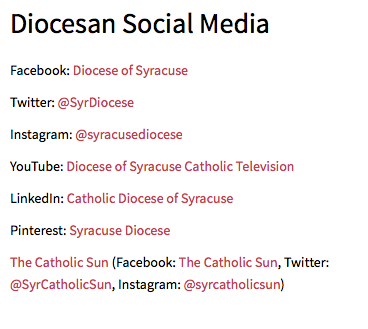The Diocese of Syracuse is a component of one of largest and oldest organizations in the world, the Catholic Church. It serves approximately 185,000 Catholics in 7 counties in Upstate New York. They are also one of the top 5% employers; and true to their mission - “Know your faith, live your faith, share your faith”, they serve the community through schools, hospitals and churches etc. For strategic purposes, they are the communication arm of the Church, which essentially requires them to build and maintain good relationships with, and constantly engage with the community to further values of their faith.
Using social media as a means of effective and rapid communication amounts to a paradigm shift for the church. A rapidly (and ever-changing) technological landscape also poses enormous challenge, as the Catholic Church has been slow to adapt to the new environment. They first started to use emails for internal communications in the year 2000, and still struggle with getting individuals to use communication tools available on the internet such as email and social media platforms. The church is quickly catching up, however. It is really an educational process to get the parish representatives up to speed on how you access the website and social media accounts. Currently, they are transitioning from having a single person operating a facebook and twitter account, to now having a person who is dedicated to not only operating various social media platforms, but also to establish linkages to provide the same content across various platforms. More recently, apart from using traditional media such as the Catholic Sun newspaper and radio, they are now also using a whole range of social media platforms to schedule campaigns and for advocacy on issues such as the education tax credit. Their communication has been so effective as to bring people who hadn’t been to confession for as long as 43 years, back to the church. 
Currently, all the content pushed on various social media platforms is first scrutinized at a higher level (the bishop and the chancellor). Once approved, the content is only posted by a single account administrator. The content is largely based on the current campaigns being organized by the church and other topical issues relevant at the time. They also make a constant effort to elicit feedback on their posts and respond to the feedback if necessary. Inappropriate comments in the feedback are also deleted, but rarely. They also monitor content on open public pages such as Topix to be able to prepare and to respond to any accusations against the organization or its officials and on various issues of public interest, wherever necessary. They monitor the effectiveness of social media communication by analyzing facebook analytics and are also in the process of identification and increasing the number of knowledge hubs in their networks.
The existing policies do not provide for a framework to allow multiple account-administrators in the organization. They are now reformulating all their social media policies so that they can put a structure in place that not only protect their employees but also be better prepared for effective communication especially during crisis situations. They are also building upon their “safe environment” policy. Everyone that works for the church has to undergo training for safe environment, enabling them understand how to recognize and report abuse. They are extending this strategy to social media, making sure that administrators understand that these policies extend to the digital world.
No comments:
Post a Comment